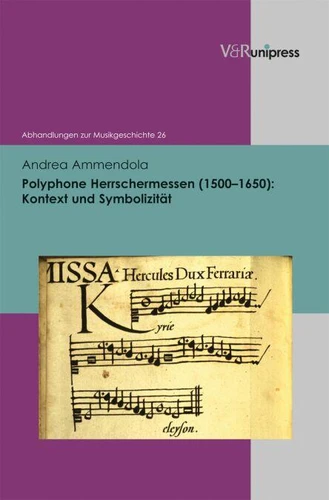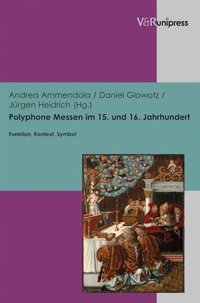Polyphone Herrschermessen (1500–1650). Kontext und Symbolizität
Par : , , , ,Formats :
Disponible dans votre compte client Decitre ou Furet du Nord dès validation de votre commande. Le format PDF est :
- Compatible avec une lecture sur My Vivlio (smartphone, tablette, ordinateur)
- Compatible avec une lecture sur liseuses Vivlio
- Pour les liseuses autres que Vivlio, vous devez utiliser le logiciel Adobe Digital Edition. Non compatible avec la lecture sur les liseuses Kindle, Remarkable et Sony
 , qui est-ce ?
, qui est-ce ?Notre partenaire de plateforme de lecture numérique où vous retrouverez l'ensemble de vos ebooks gratuitement
Pour en savoir plus sur nos ebooks, consultez notre aide en ligne ici
- Nombre de pages344
- FormatPDF
- ISBN978-3-86234-963-0
- EAN9783862349630
- Date de parution19/06/2013
- Protection num.pas de protection
- Taille6 Mo
- Infos supplémentairespdf
- ÉditeurV&R Unipress
Résumé
Integrating texts of homage for secular rulers in sacral mass settings may at first sight seem to be a contradiction. In actual fact, however, the mass - the most liturgical of all genres - was particularly attractive to Renaissance composers as a form of paying homage to a ruler. This study is the first to present a systematic examination of masses for secular rulers from their beginning in around 1500 (Josquin Desprez' "Missa Hercules Dux Ferraria") to the mid-17th century.
It analyses and correlates the historical contexts, compositorial style and symbolism of masses from Italy, Spain, Portugal and the House of Habsburg. The outstanding feature of masses for secular rulers is their instrumentalisation as demonstrations of political power using the liturgical mass as a medium. In masses for secular rulers the sacral aspect of the renaissance ruler are brought to a culmination, sonorously symbolising, as it were, the divine legitimation of their rule.
It analyses and correlates the historical contexts, compositorial style and symbolism of masses from Italy, Spain, Portugal and the House of Habsburg. The outstanding feature of masses for secular rulers is their instrumentalisation as demonstrations of political power using the liturgical mass as a medium. In masses for secular rulers the sacral aspect of the renaissance ruler are brought to a culmination, sonorously symbolising, as it were, the divine legitimation of their rule.
Integrating texts of homage for secular rulers in sacral mass settings may at first sight seem to be a contradiction. In actual fact, however, the mass - the most liturgical of all genres - was particularly attractive to Renaissance composers as a form of paying homage to a ruler. This study is the first to present a systematic examination of masses for secular rulers from their beginning in around 1500 (Josquin Desprez' "Missa Hercules Dux Ferraria") to the mid-17th century.
It analyses and correlates the historical contexts, compositorial style and symbolism of masses from Italy, Spain, Portugal and the House of Habsburg. The outstanding feature of masses for secular rulers is their instrumentalisation as demonstrations of political power using the liturgical mass as a medium. In masses for secular rulers the sacral aspect of the renaissance ruler are brought to a culmination, sonorously symbolising, as it were, the divine legitimation of their rule.
It analyses and correlates the historical contexts, compositorial style and symbolism of masses from Italy, Spain, Portugal and the House of Habsburg. The outstanding feature of masses for secular rulers is their instrumentalisation as demonstrations of political power using the liturgical mass as a medium. In masses for secular rulers the sacral aspect of the renaissance ruler are brought to a culmination, sonorously symbolising, as it were, the divine legitimation of their rule.




